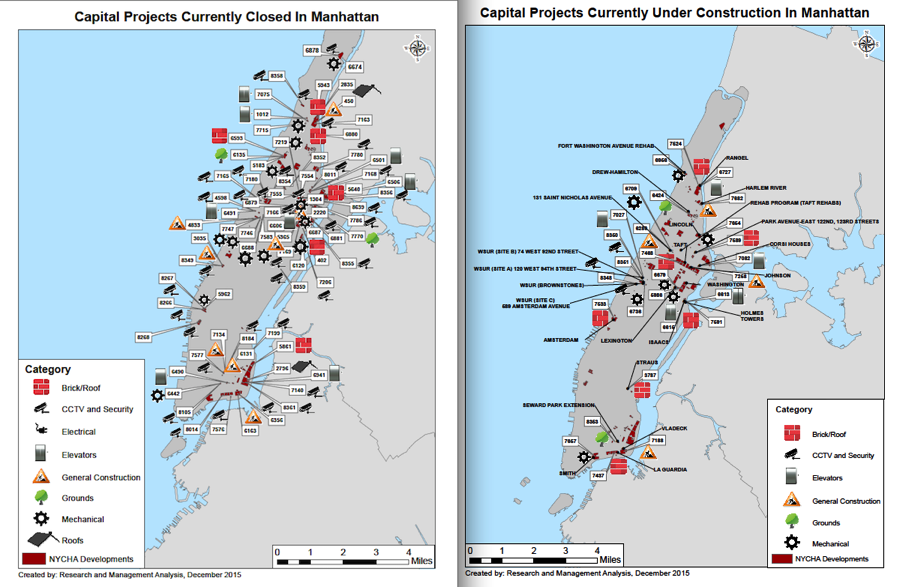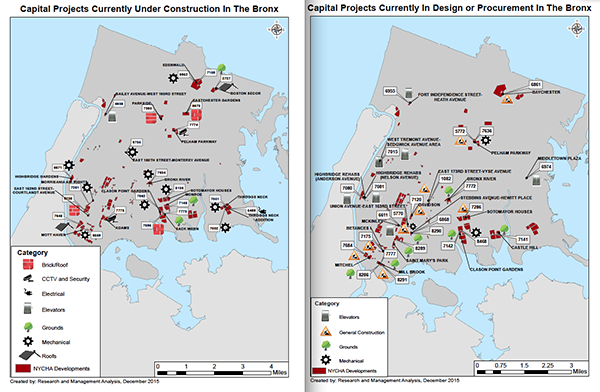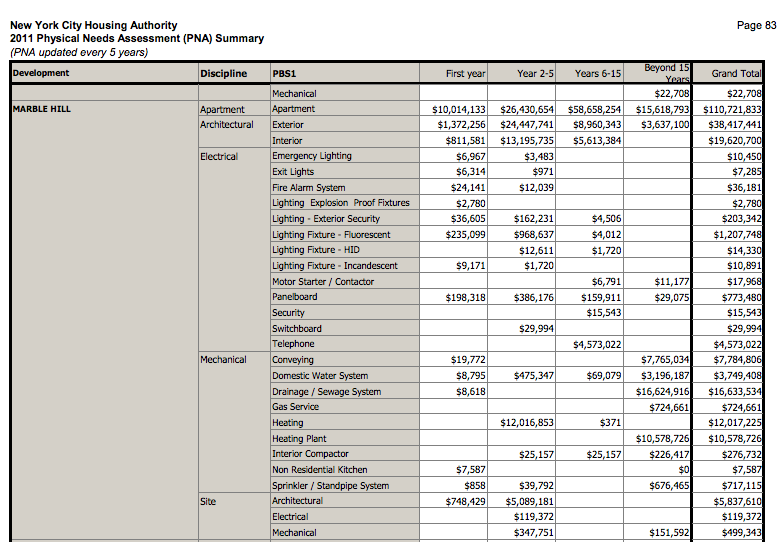
David Schalliol, from Affordable Housing in New York
Over the past two decades the pages of New York City's dailies have been filled with a growing chorus of complaints about declining conditions in the New York City Housing Authority's vast system (178,000 apartments). Multiple reports by city officials, activists, and NYCHA's own metrics, have highlighted problems such as slow elevators, leaks, broken windows, delayed repairs, and unlocked lobby doors. Two decades of cutbacks have indeed reduced quality of life for residents when compared to the robust federal capital and operating funds of the 1990s. Fewer skilled staff, old buildings, higher energy costs, and late rents are just a few of the challenges faced by today's NYCHA administrators.
It is easy to lose sight, in the face of so much bad news, of the reason why New York has these maintenance problems while so many cities do not: NYCHA and city leaders are preserving large scale high-rise public housing against the national tide. Federal capital and operating subsidies, which continue to provide the bulk of NYCHA's revenues after rents, have been slashed. Most American big cities took the comparatively easier road of knocking down aging towers, even if it meant losing thousands of permanent, low-cost, subsidized apartments.
A new series of Geographic Information System (GIS) maps created by NYCHA document capital projects across the city and provide a revealing portrait of what is working today, and what still needs to be done, to upgrade "First Generation" NYCHA for the half a million New Yorkers who still live within its walls.

The maps, only a few of which are shown here, vividly illustrate that NYCHA is slowly rebuilding the thousands of aging towers in the system. The maps, and accompanying spreadsheets, indicate that many developments during the past decade or so have benefitted from new elevators, roofs, brickwork, parapets, electrical upgrades, security cameras, and updated mechanical systems.
NYCHA's Capital Projects Division oversees and designs the various projects, but private contracting firms, selected through a competitive bidding process, do the construction on a for-profit basis. Rebuilding NYCHA - where 400,000 New Yorkers live - is not just about housing, then, but it is also a public/private partnership that has pumped billions into the local economy. Hundreds of NYCHA residents have also gained work experience through these renovation projects.
The individual capital items are necessarily rendered as small icons on these maps but on the ground each icon represents a big and expensive undertaking because each individual NYCHA housing project is so large. A single icon on the map, for instance, usually involves multiple roofs, elevators, and brick repointing efforts at one project. These capital projects, moreover, are distinct from the millions of smaller repairs every year undertaken by NYCHA maintenance employees as part of everyday maintenance.
These large capital projects are not just being started, as the maps indicated, but also completed in a timelier manner than in the past. NYCHA has picked up the pace on its design, procurement, and contracting process. The NYC Stimulus Tracker, new staff and procedures, a recession (making NYCHA contracts more desirable for private construction firms that once dragged out the process), and public scrutiny are some of the factors in this speed up.

The maps also speak to baseline, long-term priorities: keeping out rain; delivering heat, electrical and water service; and installing safer elevators. The maps are thus full of roof, brickwork, parapets, and mechanical projects (plumbing, electric, and elevators) rather than apartment rehabilitation. Many residents, as reported in the newspapers, would likely prefer that NYCHA place an immediate emphasis on total apartment rehabs so that their lives improve now; the hundreds of thousands of monthly maintenance calls indicate a large, and possibly growing, number of defects per apartment.
From a long-term perspective, however, and in the current pinched budget situation, the strategy of securing building envelopes first makes sense. Expensive apartment rehabs, and even smaller patch jobs, often make good press, but they can be quickly undone, and often are, by a faulty heating pipe or leaky wall. Most NYCHA residents are therefore likely to remain dissatisfied with the state and number of defects in their aging apartments in the short term even with new roofs or brickwork protecting them in the years to come. Doing the right thing—using funds in a strategic way—thus remains politically risky when so much attention is focused on apartment repairs today.
This basic strategy of maintaining buildings envelopes is sound, but it is fair to say that even this prioritization of scarce resources is not guaranteed to secure NYCHA's future as a housing provider. NYCHA estimates that it needs an additional $17 billion in capital funds just for the next five years. A longer horizon on capital needs reveals an even larger capital need. Parsons Brinckerhoff, the global engineering and design firm, in 2011 estimated that NYCHA would face $30 billion in basic capital costs from 2011 to 2026—a figure far in excess of what was then or is currently available from city, state, or federal sources combined. When a roof project at Pink Houses costs over $37 million, an elevator project Roosevelt Houses demands $4 million, and brickwork at Glenwood Houses comes in at over $42 million—just a couple examples from hundreds—it is easy to see how NYCHA could still have billions in needed capital repairs over the coming decades. The cost of construction of all kind is expensive in New York and NYCHA is subject to both market pressure and federal labor regulations.
Were NYCHA to generate similar style maps using icons to show the additional major capital projects needed, these maps of needed work would be far more crowded than the maps of ongoing capital projects today. The required work for one housing project, Marble Hill Houses (1682 apartments) is provided as an example below of the amount of money that would be needed to upgrade just one project from top to bottom. The figures from the 2011 Physical Needs Assessment indicate that renovating Marble Hill to a good state would absorb a significant share of an entire year's worth of NYCHA's federal capital budget (to be spent system-wide) despite counting only about 1% of NYCHA's total apartments. Marble Hill's needs, moreover, are fairly typical for large NYCHA developments.

The maps and data sampled here answer many questions about what is being done to secure NYCHA's future, the locations of major projects, and what it costs to just partially rebuild America's largest public housing system. The maps do not, however, answer more worrisome questions about future funding and projects. This uncertainty is why NYCHA leaders continue to pursue new routes to renovation such as converting traditional public housing units to Section 8 and generating revenues from new market-rate housing on public housing grounds. Many solutions, and many big ones, are going to be needed to secure this housing for another generation.
*This is the first of a three-part series on NYCHA from Nicholas D. Bloom and partners*
Read part two: Goodbye to 'First Generation' NYCHA
Read part three: Looks Matter, Especially in Public Housing
***
Nicholas Dagen Bloom is Co-Curator of the current exhibition at the Hunter College, East Harlem Gallery, Affordable Housing in New York and Co-Editor of the anthology by the same name, available here.
***
Have an op-ed idea or submission for Gotham Gazette? Email This email address is being protected from spambots. You need JavaScript enabled to view it.




